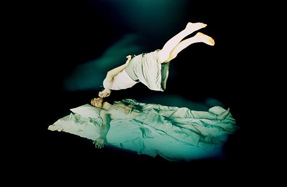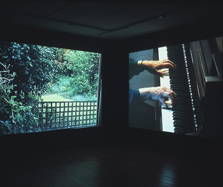 |
|
 |
Rieko Shiga, "Chiako," from the series Canary, 2006
Chromogenic print, courtesy of the artist |
|
Shizuka Yokomizo, "Forever (and again)," 2003
Video installation, courtesy of Wako Works of Art |
|
Think contemporary art, consider "the body," and an all-too-familiar set of in-your-face tropes and themes is apt to flash to mind: sex, violence, confinement, discipline, the body as raw sculptural material, the body as canvas of political conflict, bodies codified, bodies commodified, and so on. . . The Tokyo Metropolitan Museum of Photography's current exhibition, On Your Body: Contemporary Japanese Photography, pleasingly upsets these easy expectations with work marked by subtlety, grace and suggestive implication.
Once a year the TMMP exhibits a group of artists thought to represent "the now" of photography in Japan. This year's six participants all happen to be female and most are relatively young. Although the stated theme of the exhibition is "the body," a more precise handle might have been "embodiment." These photographers are not much interested in the body as aesthetic form or political battleground. Their shared concerns are our bodies' fragility and ephemerality, the common incongruity between outward appearance and inner sense of self, and the ultimately unfordable gulf that exists between us all, as individually embodied subjective beings. In paraphrase of the late David Foster Wallace, they give us cause to reconsider how we are all marooned in our own private skulls, from which true imaginative access to other selves would require a miracle of inspiration that might, after all, be impossible.
The exhibition is thoughtfully installed, with each artist sharing an element of thematic continuity with her neighbor. Various piano renditions of a Chopin waltz, the audio track of London-based artist Shizuka Yokomizo's two-channel video installation, echo throughout the space, providing pleasant and oddly appropriate accompaniment to all the work on view. In Yokomizo's installation, four women appear in a sequence on a wall-sized screen, each giving a short performance of the Chopin piece on her own home piano. On a second screen placed adjacent, we are shown stationary shots of the women's living rooms and gardens. The ladies are all over seventy years old. Their hands at the piano are veined and knotted with age, yet they play with precision and poise. As Yokomizo suggests in her artist statement, "music provides the passage of time with a temporary, palpable texture," and "age is the accumulation of minute traces that time leaves on the body." The empty stationary shots establish the scene of these women's daily lives, giving one a sense of long, quiet hours spent alone. Their expert performances imply a lifetime of practice and dedication to music. As they play, their expressions remain blank and serene. We are left wondering over all their lost time, with the metronomic progression of the waltz stepping on and on, in perfect measure.
The photos of Yoko Asakai reveal people similarly imperturbable as they sit engrossed in art -- but with a twist. In her series Watch, Asakai presents richly colored, high contrast, mid-sized photos of people watching movies in their homes -- one of the most universal of pastimes, the world over. After her subjects had selected a title and prepared beverages and munchies in their ordinary movie-time fashion, Asakai placed her camera at a point behind and beside the television. While the subjects then watched the movie, her camera watched them. She took the photos sporadically, without offering forewarning. What first struck me about the images is the rather displeased and stuporous expression shared by all the movie-viewers, regardless of their age or nationality. I felt my own expression then suddenly rise into a grin, as I realized I had been holding the same glumly torpid look, as I assessed Asakai's photos and entertained this very thought about them. Has Asakai captured the visage of aesthetic absorption? Her project exaggerates and focuses upon a regular feature of our everyday, inter-subjective, social experience. An alluring entertainment before them, an all-seeing camera trained on them, Asakai has placed her models in a psychic situation of polar opposites. Either they've been drawn into the inward, dream-making action of movie viewing, and are relatively oblivious to their surroundings and self-presentation; or they are posing, and thus absolutely self-conscious and focused on their outward appearance and the impression they are offering up to the eyes around them. Photo by photo we wonder which is the case, and there's simply no way to know.
The other unmentioned photographers are no less compelling. As Chopin wafts from room to room, each exhibitor picks up the tune of the body in her own register and passes it on to the next player. Collectively, the photography of On Your Body entices us to consider nothing less than the endlessly mysterious, universal human experience of subjective existence both in and as a body -- a body that is, paradoxically, itself a part of the objective world it somehow seems to stand against.
 |
|
 |
Yoko Asakai, "The Seventh Seal," Berlin, 2006
Chromogenic print, courtesy of the artist and Mujin-to Production |
|
Yoko Asakai, "Home Alone," Tokyo, 2007
Chromogenic print, courtesy of the artist and Mujin-to Production |
|
|
|